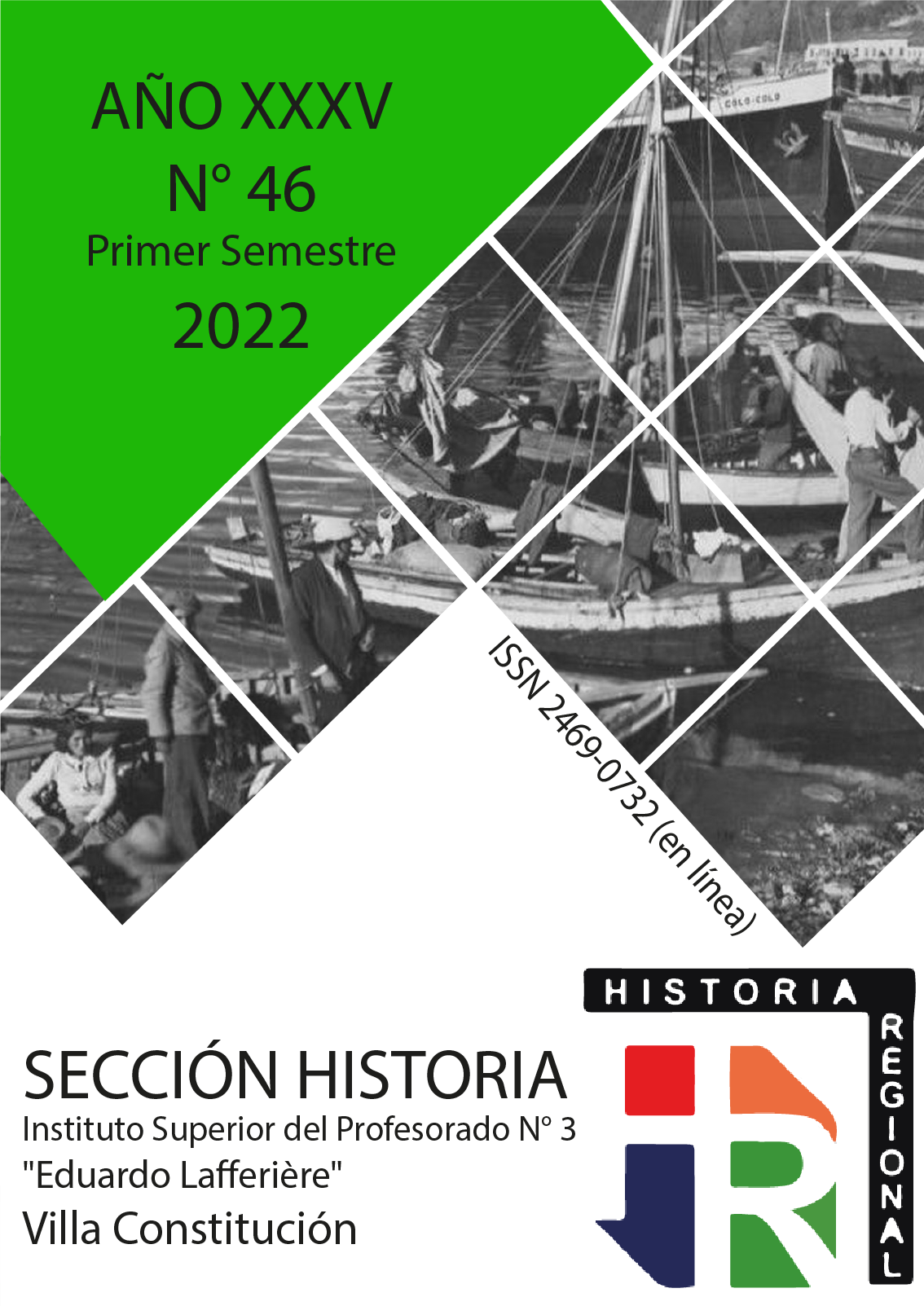Forms of work and production from the privatization of Somisa from the perspective of the resulting labor collective
Main Article Content
Abstract
In recent years, there have been frequent investigations about the underlying principles in the historiographic constructions resulting from the social impact of the privatization context in Argentina from the 90's. This work also tries to bring us closer to another point of analysis convergent to this context. We are faced with the need to answer some questions that emerge within Ternium (Ex-Somisa) steel’s factory, almost thirty years after the privatization program of the 90s. With the establishment of neoliberal policies, important changes have occurred in the structure and organization of the productive schemes of the plant, which have a direct impact on the relations and practices of meanings of the working group. Here we have sought to approach the problem by focusing attention on the manufacturing experiences of a group belonging to the context prior to the privatization of the company, which after continued in the irruption of neoliberalism at the national political scene.
Downloads
Download data is not yet available.
Article Details
How to Cite
Cipriani, N. (2021). Forms of work and production from the privatization of Somisa from the perspective of the resulting labor collective. Historia Regional, (46), 1-22. Retrieved from https://historiaregional.org/ojs/index.php/historiaregional/article/view/592
Section
Learning the trade

This work is licensed under a Creative Commons Attribution 4.0 International License.
Los autores que publican en esta revista están de acuerdo con los siguientes términos:
- Los autores conservan los derechos de autor y garantizan a la revista el derecho de ser la primera publicación del trabajo al igual que licenciado bajo una Creative Commons Attribution License que permite a otros compartir el trabajo con un reconocimiento de la autoría del trabajo y la publicación inicial en esta revista.
- Los autores pueden establecer por separado acuerdos adicionales para la distribución no exclusiva de la versión de la obra publicada en la revista (por ejemplo, situarlo en un repositorio institucional o publicarlo en un libro), con un reconocimiento de su publicación inicial en esta revista.
- Se permite y se anima a los autores a difundir sus trabajos electrónicamente (por ejemplo, en repositorios institucionales o en su propio sitio web) antes y durante el proceso de envío, ya que puede dar lugar a intercambios productivos, así como a una citación más temprana y mayor de los trabajos publicados (Véase The Effect of Open Access) (en inglés).
References
Cipriani, N. (2019). Colectivo Terniunero: La construcción social y subjetiva de un nuevo grupo obrero resultante del contexto de pos-privatización, a través de las representaciones del colectivo Somisero precedente. (Trabajo Final del Espacio de Definición Institucional: Seminario de Historia Regional). Sección Historia. Instituto Superior del Profesorado Nº 3. Villa Constitución. Argentina.
Correa, M. (2011). El aporte de la historia oral para un estudio de los grupos dirigentes. El rol de los sindicatos en la privatización de SOMISA. Cuadernos del Ciesal, 8(10) julio-diciembre. Recuperado de: https://issuu.com/ciesal/docs/ciesal_10_julio-diciembre_2011
Fernández, A. (1985). Las prácticas sociales del sindicalismo (1976-1982). Buenos Aires: CEAL.
García Linera, A. (2009). Forma valor y forma comunidad. Aproximación teórica-abstracta a los fundamentos civilizatorios que preceden al Ayllu Universal. La Paz: CLACSO/Muela del Diablo/Comuna. Recuperado en: http://biblioteca.clacso.edu.ar/gsdl/collect/clacso/index/assoc/D1242.dir/garcial2.pdf
Iñigo Carrera, N. (13 enero 2016). La clase obrera en E. P. Thompson y en Karl Marx. Recuperado de: https://kmarx.wordpress.com/2016/01/13/la-clase-obrera-en-e-p-thompson-y-en-karl-marx/
Jodelet, D. (1988). La representación social: fenómenos, concepto y teoría. En S. Moscovici (Ed.). Psicología social II. Pensamiento y vida social. Psicología social y problemas sociales. Barcelona: Paidós.
Marx, K. (1975). El Capital. México: Siglo XXI Editores.
Montoya Suarez, O. (2009). Tecnología y acumulación de capital en la fase actual del Capitalismo. Scientia et Technica, XV(42). Universidad Tecnológica de Pereira. Recuperado de: https://revistas.utp.edu.co/index.php/revistaciencia/article/view/2633/1437 DOI: https://doi.org/10.22517/23447214.2633
Orlansky, D., L. Grottola y M. Kantor (2006). Argentina después de la crisis: continuidades y rupturas. Revista de la Facultad de Ciencias Sociales (UBA), 65, 24-25.
Primo, R. (2006). SOMISA; una historia de acero. San Nicolás: Ediciones del Autor.
Soul, M. J. (2014). Somiseros, la configuración y el devenir de un grupo obrero desde una perspectiva antropológica. Rosario: Protohistoria.
Thompson, E. P. (1989). La formación de la clase obrera en Inglaterra. Barcelona: Crítica.
Correa, M. (2011). El aporte de la historia oral para un estudio de los grupos dirigentes. El rol de los sindicatos en la privatización de SOMISA. Cuadernos del Ciesal, 8(10) julio-diciembre. Recuperado de: https://issuu.com/ciesal/docs/ciesal_10_julio-diciembre_2011
Fernández, A. (1985). Las prácticas sociales del sindicalismo (1976-1982). Buenos Aires: CEAL.
García Linera, A. (2009). Forma valor y forma comunidad. Aproximación teórica-abstracta a los fundamentos civilizatorios que preceden al Ayllu Universal. La Paz: CLACSO/Muela del Diablo/Comuna. Recuperado en: http://biblioteca.clacso.edu.ar/gsdl/collect/clacso/index/assoc/D1242.dir/garcial2.pdf
Iñigo Carrera, N. (13 enero 2016). La clase obrera en E. P. Thompson y en Karl Marx. Recuperado de: https://kmarx.wordpress.com/2016/01/13/la-clase-obrera-en-e-p-thompson-y-en-karl-marx/
Jodelet, D. (1988). La representación social: fenómenos, concepto y teoría. En S. Moscovici (Ed.). Psicología social II. Pensamiento y vida social. Psicología social y problemas sociales. Barcelona: Paidós.
Marx, K. (1975). El Capital. México: Siglo XXI Editores.
Montoya Suarez, O. (2009). Tecnología y acumulación de capital en la fase actual del Capitalismo. Scientia et Technica, XV(42). Universidad Tecnológica de Pereira. Recuperado de: https://revistas.utp.edu.co/index.php/revistaciencia/article/view/2633/1437 DOI: https://doi.org/10.22517/23447214.2633
Orlansky, D., L. Grottola y M. Kantor (2006). Argentina después de la crisis: continuidades y rupturas. Revista de la Facultad de Ciencias Sociales (UBA), 65, 24-25.
Primo, R. (2006). SOMISA; una historia de acero. San Nicolás: Ediciones del Autor.
Soul, M. J. (2014). Somiseros, la configuración y el devenir de un grupo obrero desde una perspectiva antropológica. Rosario: Protohistoria.
Thompson, E. P. (1989). La formación de la clase obrera en Inglaterra. Barcelona: Crítica.

